There are so many reasons why your car wouldn't start. But when the problem comes from a blown fuse, all the possibilities to start your engine will be gone. Until you have found and replaced it, it is impossible to transfer electric current to the electronic parts that help start your engine.
Fuse problems highlights
- Level of urgency:medium
- DIY inspection:possible
- DIY repairs:possible
- Can you drive?yes, if it starts
- Price of repairs:$0 - $50
- Ifignored:certainequipment will not be working at all
- Ways to fix:test the fuses, replace the blown fuse

The Role of Fuses
Your vehicle's electrical system is essential for starting and running the vehicle. It consists of many electrical parts that work together so your car can generate the power it needs to start and run.
However, the surge in electricity could sometimes be unpredictable and cause electrical devices and components to blow up. For this reason, it needs a safety component that can take this power surge and convert them to more manageable energy for electrical components or devices. This is the point where fuses take place.
A fuse is a small component that can take high voltages of electricity. It serves as a safety device that protects electronic devices from excessive current. While it could take these surge amounts, the device is often made of a small wire that could melt. When the fuse blows up and the wire melts the circuit breaks. At this point, the fuse connected to starting up the vehicle will not receive electricity and function since it does not receive power.
Signs that a Blown-up Fuse Causes Your Vehicle Not to Start
Here are the indications that a blown-up fuse caused your vehicle not to start:
- Complete loss of power
A blown fuse will cut off the power supplied to the electrical component. You will feel this power loss when you turn the engine on.
- Clicking noise
As you turn on the ignition, you will hear a clicking noise if the fuse has blown. This fuse must be the one supplying electricity to the starter motor.
- The engine cranks but won't start.
If you're trying to start the engine and it doesn't ignite even if it is cranking, you must have a blown fuse in the fuel or ignition system.
- Warning lights on the dashboard
Warning lights could appear on your dashboard if you have a blown fuse. For example, a blown fuse for the fuel pump may trigger the fuel system warning or check engine light.
Fuses that Start and Stop the Motor
Some fuses protect electrical components and systems responsible for starting the engine.
1) Starter Fuse
A starter fuse is a safety device that protects the starter motor from a sudden jolt of electricity. This fuse activates when there is a problem with the starter motor. If you turn on the ignition, the electricity starts flowing on the starter circuit, and the starter motor will run. But if the fuse detects an unusual surge of electricity, the starter fuse will block this current and prevent it from going through the starter motor.
If the electricity exceeds the capacity of the fuse, it will blow, and the fuse circuit will melt. A blown-up fuse will cut the electricity needed to turn the engine on.
To fix this problem, you need to locate and replace the fuse.
2) Ignition Fuse
The ignition fuse is a safety device that works with the ignition system. Additionally, this fuse also connects with the system's fuel pump system and Electronic Control Module (ECM). Although, it primarily protects the ignition system from electrical overload and short circuits.
When there is an overload of electricity or a short circuit, the electrical current may exceed the capacity of the fuse. Exceeding its capacity means the fuse will heat up and eventually meet or blow. From there, the current will not pass through the ignition system, preserving it in good condition.
Again, look for this particular fuse in the fuse box to replace it. But if the fuse repeatedly blows up, there is more problem than just a blown fuse.
3) Fuel pump fuse
The fuel pump pulls gas from the tank and transfers it to the engine. It needs electricity to do this specific job. When turning on the ignition key, the electricity flows to the relay and activates the fuel pump. It utilizes a fuse to protect it from overloading or circuit shortage. You will find this fuse in between the relay and the fuel pump. Normally, you should hear an audible noise when you turn the ignition key on if the relay activates with electricity.
When the fuel pump fuse experiences a sudden jolt of electricity, the metal strip inside the fuse will break or blow. This event will stop the flow of electricity going to the fuel pump relay and cause the pump not to deliver fuel to the engine.
4) The main fuse
The main fuse protects most electrical systems in your car. In some vehicles, there could only be one or multiple main fuses that feed the electronic systems.
The main fuse is much harder to blow as it could be rated between 80 and 250 amperages. It could feed power to multiple systems like window switches, audio systems, alarm systems, fuel pumps, or the computer. The main fuse protects all these systems. However, it doesn't mean that it will not blow.
So when it blows up, most electronics in your system will not turn on, including your ignition system. You won't be able to start your car. You need to replace the main fuse with the same type and rating.
Locate your main fuse in the fuse box. This fuse is more distinguishable than other fuses as it is usually larger. But to be sure, get your owner's manual and check the fuse diagram.
How to Diagnose a Blown-up Fuse?
The first step in diagnosing a blown-up fuse is finding its location. You'd often find the starter fuse on a box found, near the engine compartment on the left backside.
Now that you've found where the fuse box is, you can start visually inspecting the fuse. Look for signs of burning or breakage in the wire strip inside the fuse. Sometimes, a blown fuse does not look burnt at all. You can test it with a multimeter for continuity. In these cases, you may get confused with the many fuses in the box. Get your manual and look for the location of your fuse.
After finding the fuse, replace it with the same amperage rating. If the fuse keeps blowing after being replaced, there could be more problems in your system.
Other Fuse-related Problems that Prevent the Engine from Starting
While a blown fuse is one of the common reasons, some other problems related to the fuse could also affect the electric power supplied to the engine.
- Loose connections and corrosion
Loose connections or corrosion may intercept the transfer of electricity on the circuits between the fuse and electrical systems responsible for starting the engine, like the fuel pump and ignition. Even if you do not have a blown fuse, loose connections, and corrosion can prevent the engine from starting.
First, disconnect your battery. If there are no blown fuses, clean the corroded connections with sandpaper or a wire brush. After cleaning, tighten the connection, and test the system.
- Faulty ignition switch
The ignition switch delivers power from the battery to the starter motor, spark plugs, fuel, and ignition system. When you turn this switch on, it triggers the starter solenoid and sends power to the starter motor. So if you do not have a blown fuse, a fault from this specific part will prevent the starter motor and ignition system from powering up.
Consult your technician for an accurate diagnosis.
- Bad starter relay
A starter relay automates the transfer of power to the engine. When turning the ignition key on, the starter relay redirects and transfers the electrical power feed from the battery to the starter solenoid. The starter solenoid activates the starter motor, which turns the engine over.
If this component is faulty, the electricity feed from the battery will not go through the starter motor, preventing the engine from starting.
In these cases, you need to replace it.
- Shorted component
A shorted component may prevent your car from starting. A short circuit can cause an excessive flow of electricity in the circuit connected to components critical for the starting system. This excessive flow can be more than the fuse can handle. For example, the excessive current draw in a shorted starter motor will prevent the engine from receiving adequate electrical energy to turn it over. Good thing most modern cars today can detect these problems and trigger trouble codes for easy identification.
Final Words
Fuses are essential safety devices that help control the inflow of electricity to your car components. Without these devices, electrical surges could destroy car components that start your engine. They do not only protect the devices, but they also prevent fires. These fuses that affect the starting of your motor could interrupt the flow of electricity needed to power up your engine.
Locate these fuses as soon as possible to perform necessary replacements. In cases where you cannot identify them in the fuse box, refer to your manual for accurate locations. You would want to locate the starter, ignition, fuel pump, and main fuses. Test them for continuity.
About the authors
The CarAraC research team is composed of seasoned auto mechanics and automotive industry professionals, including individuals with advanced degrees and certifications in their field. Our team members boast prestigious credentials, reflecting their extensive knowledge and skills. These qualifications include: IMI: Institute of the Motor Industry, ASE-Certified Master Automobile Technicians; Coventry University, Graduate of MA in Automotive Journalism; Politecnico di Torino, Italy, MS Automotive Engineering; Ss. Cyril and Methodius University in Skopje, Mechanical University in Skopje; TOC Automotive College; DHA Suffa University, Department of Mechanical Engineering






Add comment